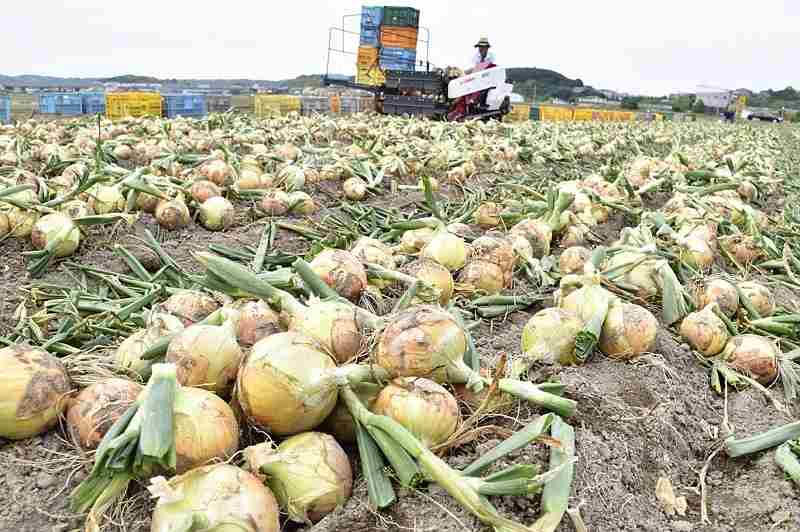
A farmer uses a machine to harvest onions on Awaji Island in Hyogo Prefecture in early June.
14:56 JST, June 25, 2022
KOBE — Many households can’t do without onions, but the rising retail price of the produce — more than double that in an average year since late April — has not only hit shoppers, but also cast a shadow over school lunches and the restaurant business.
Unfavorable weather in major production areas has affected the supply of onions. Though the shortage is expected to be alleviated as harvest season has come to Hyogo Prefecture — the No. 3 onion producing area in Japan after the leader Hokkaido and runner-up Saga Prefecture — where onions are growing well on Awaji Island. But high prices are likely to continue through the summer.
At the beginning of this month, the price tag for Awajishima onions displayed at a fruit and vegetable store in the Motomachi district of Kobe was ¥128 per piece. The usual price is around ¥60.
“I’m looking for a place that sells them at a reasonable price, as they are a must for the dining table,” said a 58-year-old woman shopping there. “I hope prices will go down soon.”
According to a store employee, the ongoing high retail prices means onions remain unsold.
The simple, humble onion contains high amounts of key nutrients for children, making it a regular ingredient for school lunches. Rising prices, however, have forced schools to adjust.
In May, the municipal schools in Hirakata, Osaka Prefecture, cut by half the amount of onions used for stir-fry dishes and soups. Schools in Tamura, Fukushima Prefecture, are using ingredients such as daikon in place of onions.
Popular curry restaurant Hakugintei, which has two outlets in the heart of Osaka, uses up dozens of kilograms of onions per day. Ryuichiro Oki, 44-year-old owner of the restaurant, was at a loss because he had just raised the price of some items in May due to the soaring cost of cooking oil.
“Onions are essential for natural sweetness,” he said. “We can’t imagine reducing the amount we use, so it’s quite a blow.”
Hokkaido’s harvest hit
How much does the average household in Japan spend on onions annually? According to the government’s survey of household budgets last year, each household of at least two people spent ¥3,546 per year on the crop. This figure is second only to tomatoes, at ¥7,965, among fresh vegetables.
Onion’s appeal is that it can generally be purchased inexpensively throughout the year. The low prices are the result of planting and harvesting at different times of the year in different regions.
Hokkaido accounts for nearly 70% of the domestic harvest, but last summer’s drought led to widespread poor growth and a decline of more than 20% in production compared to the previous year. Rain is necessary for onion bulbs to grow in girth, but in Kitami, one of the largest producing areas in Hokkaido, rainfall was down nearly 60% from an average year.
Even in Saga Prefecture, where harvesting began this spring, low temperatures and dry weather in early spring delayed growth, fueling the shortage of onions.
According to a survey by the Agriculture, Forestry and Fisheries Ministry, the retail price per kilogram began to exceed the average in early October last year. In early May this year, the price reached ¥581, the highest price in five years.
Hyogo’s high hopes
Although the price remains high, it has not led to an increase in farmers’ income amid rising costs for items such as fertilizer.
Expectations are high, however, for Hyogo Prefecture’s production. On Awaji Island, growth is favorable and some farmers are even expanding the planting area, according to the JA Awajishima local agricultural cooperative.
What will happen to retail prices in the future? The ministry expects it will take some time for prices to return to normal levels since consumer demand is high.
“It is difficult to rely on producers to stabilize prices because products for the dining table are in high demand and their prices can fluctuate widely even with small changes in supply,” said Hokkaido University Prof. Hiroshi Sakazume. “When the harvest is low, consumers might have to lower their consumption behavior such as by purchasing fewer items. This kind of perspective is also necessary.”
"Society" POPULAR ARTICLE
-

M4.9 Earthquake Hits Tokyo, Neighboring Prefectures
-

M7.5 Earthquake Hits Northern Japan; Tsunami Waves Observed in Hokkaido, Aomori and Iwate Prefectures
-

Tsukiji Market Urges Tourists to Avoid Visiting in Year-End
-

Israeli Tourists Refused Accommodation at Hotel in Japan’s Nagano Pref., Prompting Protest by Israeli Embassy and Probe by Prefecture
-

M5.7 Earthquake Hits Japan’s Kumamoto Pref., Measuring Upper 5 Intensity, No Tsunami Expected
JN ACCESS RANKING
-

Keidanren Chairman Yoshinobu Tsutsui Visits Kashiwazaki-Kariwa Nuclear Power Plant; Inspects New Emergency Safety System
-

Imports of Rare Earths from China Facing Delays, May Be Caused by Deterioration of Japan-China Relations
-

University of Tokyo Professor Discusses Japanese Economic Security in Interview Ahead of Forum
-

Japan Pulls out of Vietnam Nuclear Project, Complicating Hanoi’s Power Plans
-

Govt Aims to Expand NISA Program Lineup, Abolish Age Restriction























